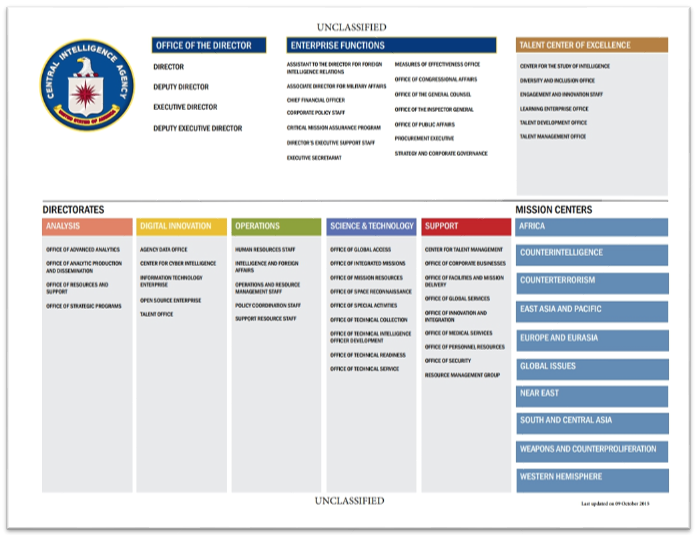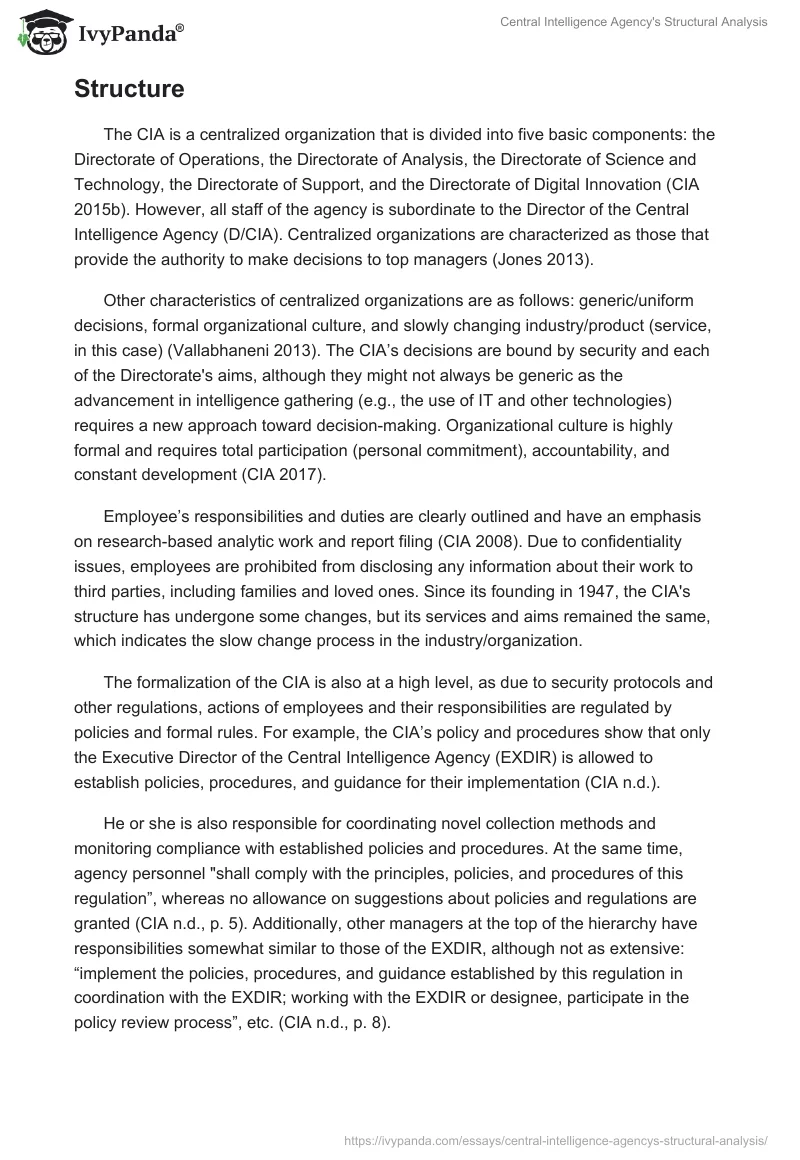Introduction
The Central Intelligence Agency or the CIA is a foreign intelligence service that is supervised by the United States federal government. It collects and analyzes foreign intelligence that can potentially impact national security by using human intelligence.
The CIA is possibly one of the largest governmental organizations that is often perceived as a mythical spy agency. I have discovered it through American and European movies and TV series that often present it as a powerful governmental tool that collects both domestic and foreign intelligence. My interest in it rose as I began to study organizational structure as an organization with such difficult tasks and assignments that relate to sensitive information must be highly formalized and standardized to avoid information leaks or human/technology errors. The aims of the essay are to conduct a structural analysis of the CIA to understand how it is organized. Coordination mechanisms of the CIA will be presented and discussed as well.
Organization: CIA
Purpose
According to the CIA (2016a), its primary mission is to collect “intelligence that matters, producing objective all-source analysis, conducting effective covert action as directed by the President, and safeguarding the secrets that help keep our Nation safe” (para. 2). The task undertaken by the organization is the collection of information via various channels: open sources such as radio, newspapers, TV news, etc., satellite images, decrypt coded messages, and the collection of information from foreign citizens (CIA 2016a).
Structure
The CIA is a centralized organization that is divided into five basic components: the Directorate of Operations, the Directorate of Analysis, the Directorate of Science and Technology, the Directorate of Support, and the Directorate of Digital Innovation (CIA 2015b). However, all staff of the agency is subordinate to the Director of the Central Intelligence Agency (D/CIA). Centralized organizations are characterized as those that provide the authority to make decisions to top managers (Jones 2013).
Other characteristics of centralized organizations are as follows: generic/uniform decisions, formal organizational culture, and slowly changing industry/product (service, in this case) (Vallabhaneni 2013). The CIA’s decisions are bound by security and each of the Directorate’s aims, although they might not always be generic as the advancement in intelligence gathering (e.g., the use of IT and other technologies) requires a new approach toward decision-making. Organizational culture is highly formal and requires total participation (personal commitment), accountability, and constant development (CIA 2017).
Employee’s responsibilities and duties are clearly outlined and have an emphasis on research-based analytic work and report filing (CIA 2008). Due to confidentiality issues, employees are prohibited from disclosing any information about their work to third parties, including families and loved ones. Since its founding in 1947, the CIA’s structure has undergone some changes, but its services and aims remained the same, which indicates the slow change process in the industry/organization.
The formalization of the CIA is also at a high level, as due to security protocols and other regulations, actions of employees and their responsibilities are regulated by policies and formal rules. For example, the CIA’s policy and procedures show that only the Executive Director of the Central Intelligence Agency (EXDIR) is allowed to establish policies, procedures, and guidance for their implementation (CIA n.d.).
He or she is also responsible for coordinating novel collection methods and monitoring compliance with established policies and procedures. At the same time, agency personnel “shall comply with the principles, policies, and procedures of this regulation”, whereas no allowance on suggestions about policies and regulations are granted (CIA n.d., p. 5). Additionally, other managers at the top of the hierarchy have responsibilities somewhat similar to those of the EXDIR, although not as extensive: “implement the policies, procedures, and guidance established by this regulation in coordination with the EXDIR; working with the EXDIR or designee, participate in the policy review process”, etc. (CIA n.d., p. 8).
As can be seen, hierarchical, top-down reporting common for organizations with a high degree of formalization can be seen in the CIA. It seems that a high level of formalization is necessary for the CIA as it clarifies role expectations, enhances perceptions of fairness, and emphasizes procedural justice (Hempel, Zhang & Han 2012; Morrow, McElroy & Scheibe 2012;). At the same time, formalization can negatively influence employees’ motivation and result in unnecessary bureaucracy.
The CIA is an organization with a tall (more than 100,000 employees and ten directorates and mission centers), mechanistic, geographic + market structure (see Table 1) (Morgan 2006). It should be noted that some directorates and functions are classified and therefore cannot be mentioned in documents for open access. Mechanistic structures are defined through individual specialization (all employees have specifically assigned tasks), simple integrating mechanisms (authority is the dominant integrating mechanism), centralization (top executives control assignment completion, communication is vertical), and rules and policies used extensively to control tasks (Jones 2013).
As described in policies above, agency’s employees are clearly instructed on their tasks, all task outputs are provided to top executives who direct those to the EXDIR, and communication is vertical (from employees to supervisors to top executives to EXDIR or in reverse order). Jones (2013) defines bureaucracy as a form of organizational structure where the personnel can be held accountable for their actions because standards and organizational policies guide their actions; the personnel needs to adhere to it. Thus, the CIA is a bureaucracy.

Coordination Mechanisms
Five coordination mechanisms are used by the CIA: hierarchy of authority, direct contact, liaison role, task force, and teams. Although hierarchy of authority is more common for highly standardized and formalized organizations, the CIA uses other mechanisms as well due to its organizational complexity and the complexity of the tasks it performs. Hierarchy of authority implies that employees are instructed about who reports to whom; in this case, directorates’ staff reports to top managers of those, whereas these top managers report to the EXDIR.
Direct contact also takes place between different offices; for example, the Office of Congressional Affairs works with the Office of the Director of the Central Intelligence Agency to “ensure successful events with the Hill” (CIA 2016b, para. 6). Liaison roles also exist in all departments; e.g., directorate components (all five directorates at the CIA) work together at arranging, supporting, and documenting congressional briefings (CIA 2016b).
Task forces are used quite often by the CIA, although mostly in the field operations. For example, a task force was formed to conduct a review of the Khowst attack, during which several CIA agents were killed (CIA 2010). The use of task forces was often required to conduct complex, classified missions that relied on the military support or were related to terrorism. During the invasion of the South Korea by the North Korea, the task force was established to provide analytic reports about communistic behavior on the peninsula (CIA 2013).
When “the war on terrorism” began, the CIA established a complex multi-agency task force that collected and analyzed intelligence about al-Qaida’s plans and intentions (CIA 2012). Eventually, exactly due to the actions and successes of this task force, the agency was able to track down and kill Usama Bin Ladin, America’s most wanted terrorist at that date.
One of the most recent investigations conducted by the CIA’s task forces related to the possible Russian funding of the Donald Trump’s campaign; the US counterintelligence task force, established in 2016, was responsible for this investigation (Bertrand 2017). It was also a multi-agency task force and included professionals from the FBI, the National Security Agency (NSA), the Treasury and Justice Departments, and the Office of the Director of National Intelligence. The task force investigated the ties of Donald Trump to Russia that were described in an audio recording handed to the Director of the CIA (LoBianco 2017). The current status of the investigation is unknown and might be classified due to its sensitivity.
The CIA’s use of teams is also extensive. For example, one of the most famous teams was the Ames mole hunt team, which helped the agency disclose Aldrich Ames as a spy for the USSR (CIA 2009). The teams in the CIA can have various responsibilities and are often involved in profoundly different tasks. The investigation of the nuclear potential of Iraq in 2004 consisted of five teams (Team Alpha, Team Bravo, Team Charlie, Team Delta, and Team Golf) that either analyzed satellite images or worked on site (CIA 2007).
As can be seen, teams in the CIA also mostly work in the field, although not all of them. For example, during a simulation competition in 2011, the team that consisted of the Directorate of Intelligence’s professionals evaluated the contestants’ ability to prepare effective briefings (CIA 2011). In this case, the team worked on promoting the prestige of the agency, educating and considering possible recruitment of suitable participants in the future. No integrating roles or departments are used in the CIA as each of the directorates has a Liaison Group that actively cooperates with others.
Conclusion
The Central Intelligence Agency is a bureaucracy: a standardized, formalized, tall, mechanistic organization that regulates the actions of its employees with policies and rules and holds every employee accountable for their actions. Due to the specifics of the agency and its work with sensitive information that might influence national security, it has to be highly standardized and formalized, because without security protocols and policies information leaks would be unavoidable.
As the CIA works on complex and sometimes dangerous tasks, it usually does not provide generic or uniform decisions, focusing on the integration of technologies and IT in its processes (e.g., cyberintelligence). The organization consists of five directorates, regional mission centers, and the Executive Staff. All of them are accountable to the Executive Director of the CIA. The agency uses the hierarchy of authority, direct contact, liaison role, task force, and teams as the main coordination mechanisms.
The first three mechanisms are usually used in the agency, whereas task forces and teams often conduct investigations and intelligence collection overseas. Due to safety rules, some organizational directorates might be classified and therefore are not included in this analysis.
Reference List
Bertrand, N 2017, Report: CIA set up task-force in 2016 to investigate possible Russian funding of Trump’s campaign. Web.
CIA 2007, Team results. Web.
CIA 2008, Chapter eight. Web.
CIA 2009, The people of the CIA… Ames mole hunt team. Web.
CIA 2010, Message from the Director: lessons from Khowst. Web.
CIA 2011, DC, Maryland, and Virginia Area College students participate in Central Intelligence Agency simulation competition held at Georgetown University. Web.
CIA 2012, The final chapter in the hunt for Bin Ladin. Web.
CIA 2013, Military directors of the CIA. Web.
CIA 2015a, Organizational structure. Web.
CIA 2015b, Who we are. Web.
CIA 2016a, CIA vision, mission, ethos & challenges. Web.
CIA 2017, Our culture. Web.
CIA n.d., Signals intelligence activities. Web.
Hempel, PS, Zhang, ZX & Han, Y 2012, ‘Team empowerment and the organizational context: decentralization and the contrasting effects of formalization’, Journal of Management, vol. 38, no. 2, p. 475-501.
Jones, G 2013, Organizational theory, design, and change, Pearson Education, London.
LoBianco, T 2017, Ex-CIA chief John Brennan: Russians contacted Trump campaign. Web.
Morgan, G 2006, Images of organization, Berrett-Koehler Publishersm, Oakland, CA.
Morrow, PC, McElroy, JC & Scheibe, KP 2012, ‘Influencing organizational commitment through office redesign’, Journal of Vocational Behavior, vol. 81, no. 1, pp. 99-111.
Vallabhaneni, SR 2013, Wiley CIA exam review 2013, internal audit practice, John Wiley & Sons, New York, NY.


